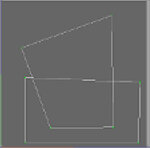Modeling Requirements
Mari has certain modeling requirements that need to be met in order to use geometry, whether the format of the geometry is an Object, Ptex, Alembic, or FBX file format.
Please bear in mind that Mari allows you to import and paint models with Overlapping UVs, like the one shown below. However, if you paint on regions in the 3D views (orthographic or perspective), which also overlap in 2D UV view, then you may encounter painting artifacts, as Mari is forced to choose which of the conflicting overlapping paint strokes to bake down. To avoid this, you should only apply paint to one of the overlapped regions at a time in the 3D views.

For example, if you paint a face where the left and right halves have been mirrored with overlapping UVs, then you should aim to only paint on one half of the face to avoid paint clashes.
Note: Paint clashing due to overlapping UVs cannot occur in the UV view, so you can always paint your model in that view if you find that your model is particularly tricky to paint in 3D views.
Models to paint in Mari should not have:
• UVs that go over 10 on the U axis - these are ignored.

• Stacked UVs - these cannot be individually selected in UV view. If you do have stacked UVs and want to select an individual UV, you need to select it in either Ortho or Perspective view first, and then switch back to UV view.
• Negative UVs - painting on these is not possible.

Although faces with degenerate UVs (UVs are squashed but their faces remain intact) can be loaded into Mari, they can cause issues in some cases. They do not occupy any space in UV, so it's impossible to properly paint on such faces. There is also the risk that some shaders may show undesirable lighting effects on faces with degenerate UVs.
For Ptex modeling, please see
For Alembic and FBX modeling, please see
